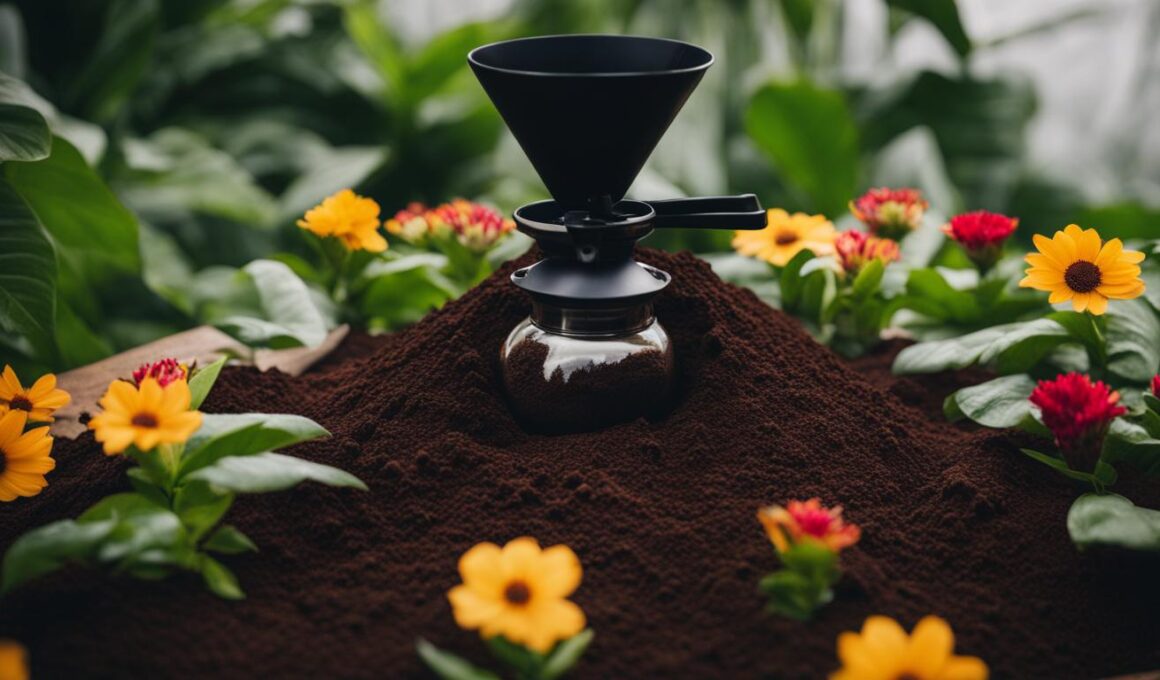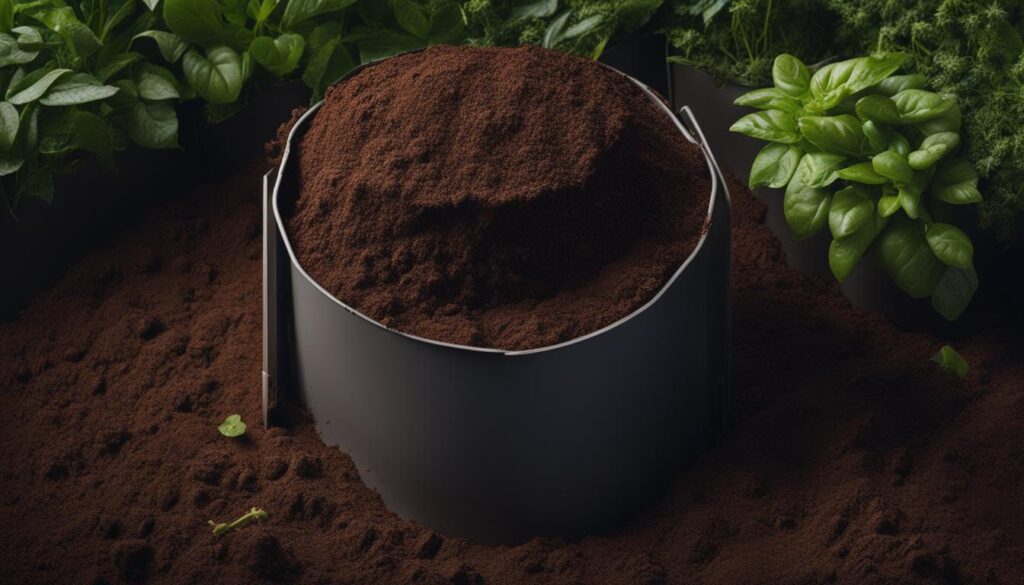Don’t throw away the coffee grounds from your morning cup of coffee—transform them into a valuable fertilizer that nourishes your garden. Rich in nutrients, coffee grounds are a sustainable and inexpensive source of organic matter that can significantly enrich your soil, enhance plant growth, and help you make the most of your kitchen waste. Find out how to maximize the benefits of coffee grounds to create a thriving garden packed with vitality.
Key Takeaways
- Coffee grounds can be an effective fertilizer and enrich your garden soil with essential nutrients.
- Add coffee grounds to your soil to provide beneficial organic matter and promote plant growth.
- Leverage the power of coffee grounds to create sustainable, eco-friendly, and cost-effective garden solutions.
- Understand how to correctly apply coffee grounds as fertilizer to avoid any potential problems related to germination or water infiltration.
- Explore various methods of using coffee grounds in your garden, including composting, soil amendment, and liquid fertilization.
- Boost your garden’s resistance against pests and fungal pathogens with the help of coffee grounds.
- Be aware of the pH effects of coffee grounds and make informed decisions on their application based on your garden’s specific needs.
The Nutritional Benefits of Coffee Grounds for Plants
Coffee grounds offer several benefits to plants due to their nutritional content. Rich in organic nitrogen, they contribute to the needed nitrogen content when added to compost. Additionally, coffee grounds include phosphorus, potassium, magnesium, and calcium—key nutrients that support various plant functions. Regularly adding used coffee grounds to soil or compost can improve soil structure and its capacity to retain water, potentially enhancing plant health and growth.
Let’s take a closer look at the specific nutrients that coffee grounds provide and how they benefit plants.
- Nitrogen: An essential element for plant growth, nitrogen contributes to leaf and stem development and the process of photosynthesis. Since coffee grounds are a rich organic nitrogen source, they can greatly benefit nitrogen-hungry plants.
- Phosphorus: This nutrient supports root growth and strength, as well as fruit and seed development. Although present in smaller amounts than nitrogen, phosphorus in coffee grounds contributes to overall plant nutrition.
- Potassium: Crucial for the overall health of the plant, potassium facilitates water and nutrient movement, helping plants withstand environmental stress. Coffee grounds supply a moderate amount of potassium, offering further soil improvement.
- Magnesium and Calcium: These micronutrients are involved in various plant functions such as cell wall structure and enzyme activities. They also support root and leaf growth. While present in smaller quantities, they play a significant role in plant nutrition.
The table below summarizes the nutritional content and the benefits of coffee grounds for plant growth and soil improvement:
| Nutrient | Content in Coffee Grounds | Benefits for Plants |
|---|---|---|
| Nitrogen | High | Leaf and stem growth, photosynthesis |
| Phosphorus | Low | Root growth, fruit and seed development |
| Potassium | Moderate | Overall plant health, stress resistance |
| Magnesium and Calcium | Low | Cell wall structure, enzyme activities, root and leaf growth |
Used coffee grounds can be an excellent addition to your garden or compost to boost plant nutrition, improve soil structure, and retain moisture. By understanding the coffee grounds benefits and their role in plant nutrition, you can harness their potential for a flourishing garden, all while contributing to sustainable, eco-friendly practices.
Composting with Coffee Grounds
Composting is a sustainable way to recycle kitchen waste and improve garden soil quality. Coffee grounds, rich in nitrogen and other essential nutrients, can be a valuable addition to your compost pile. In this section, we’ll explore the composting basics and discover how to create an ideal compost mix with coffee grounds while ensuring proper balance and maintenance.
Understanding Green and Brown Compost Materials
To achieve a balanced compost pile, it’s important to understand the distinction between green compost material and brown compost material. Green materials are rich in nitrogen and include items like food scraps, grass clippings, and coffee grounds. Alternatively, brown materials are high in carbon and consist of dry leaves, small branches, and newspaper.
Striking the right balance between green and brown materials is crucial for effective composting. Having a diverse microbial environment aids in decomposing organic matter, and an ideal compost mix should follow a 4-to-1 ratio of brown to green materials.
Perfecting the Compost Mix: The Role of Coffee Grounds
As one of the primary sources of nitrogen in compost, coffee grounds are considered green material. Nitrogen is essential for plant growth and enhances the overall quality of the compost. When incorporating coffee grounds into your compost pile, it is necessary to balance them with carbon-rich brown materials like newspaper or dry leaves.
To optimize the compost pile health and avoid issues like unpleasant odors or insufficient heating, maintain a mix that follows the 4-to-1 ratio of brown to green materials. By doing so, you’ll create an environment rich in essential nutrients, ensuring the compost supports healthy plant growth when eventually applied to the soil.
Getting the Balance Right: Tips for Composting Coffee Grounds
- Maintain a healthy compost pile: Keep in mind that coffee grounds should not make up more than 20% of your compost pile’s volume. Having a balanced mix stimulates decomposition and robust microbial activity.
- Add cool coffee grounds: To avoid harming the beneficial microbes, always wait for the coffee grounds to cool before adding them to the compost pile.
- Incorporate brown materials: Balance the coffee grounds with carbon-rich brown compost materials to create a balanced mix. Aim for a 4-to-1 ratio of brown to green compost materials.
- Monitor and aerate: Check your compost pile regularly and manually turn or aerate it to promote proper airflow and aid in speeding up the decomposition process.
- Be patient: The composting process takes time, and it is essential to wait for the compost to mature before using it in your garden.
By adhering to these composting tips, you’ll optimize your compost pile, fostering an environment where organic material is efficiently decomposed into nutrient-rich compost ready to be used in your garden.
Direct Soil Amendment with Coffee Grounds
Applying coffee grounds directly to your garden soil as a soil amendment can be an effective method of enhancing soil structure, drainage, and nutrient content, without the need for composting. There are two common techniques for coffee grounds application:
- Raking them into the topsoil
- Sprinkling them on the soil surface
Each technique offers its own benefits and drawbacks, and the choice ultimately comes down to the individual gardener’s preference and garden layout.
Note: No matter which method you choose, it is critical to avoid applying thick layers of coffee grounds, as this can impede water penetration and aeration.
Gradual application of coffee grounds is the key to achieving optimal garden soil enhancement without inadvertently creating a barrier that impacts plant growth and health. To properly apply coffee grounds using this method, follow these steps:
- Gather the used, cooled coffee grounds
- Spread the grounds evenly across the soil surface, ensuring a layer of less than 1/2 inch in thickness
- Lightly rake the grounds into the top few inches of soil to incorporate
By incorporating coffee grounds gradually and evenly, you minimize the risk of reduced water infiltration and enhance your garden’s soil structure, eventually leading to healthier, more robust plants. Regular application of used coffee grounds fosters more efficient nutrient cycling, making this practice a sustainable and cost-effective means of improving your garden’s overall health. The benefits of direct soil amendment with coffee grounds can include:
- Improved soil structure and aeration
- Increased water retention
- Enhanced nutrient content
- Reduced need for chemical fertilizers
- Encouragement of beneficial microorganisms within the soil
In conclusion, direct soil amendment using coffee grounds is a simple and effective way to enhance your garden’s growth and development. When applied correctly and consistently, this sustainable practice promotes soil health, nutrient availability, and overall plant vitality.
Creating a Coffee Ground “Tea” for Liquid Fertilization
One of the most effective ways to ensure your plants receive the benefits of used coffee grounds without causing any adverse effects on the soil structure is to make a coffee ground tea. This DIY liquid fertilizer can provide a gentle nutrient boost to your plants when used correctly. To prepare the coffee ground tea, follow these simple steps:
- Gather used coffee grounds, ensuring they are cool and dry.
- Prepare a large container that can hold up to 5 gallons of water.
- Add 2 cups of used coffee grounds to the container.
- Fill the container with 5 gallons of water.
- Allow the mixture to steep for a few hours or overnight, enabling the water to absorb the nutrients from the coffee grounds.
- After steeping, strain the liquid to remove any solid particles, retaining the nutrient-rich coffee ground tea.
You can then apply the coffee ground tea to your plants in two ways: as a liquid fertilizer or a foliar feed.
Liquid Fertilizer:
To use the coffee ground tea as a liquid fertilizer, simply water your plants with the tea, making sure to saturate the soil well. This method is highly effective for plants that require a quick nutrient boost, as the water helps deliver the nutrients directly to their roots.
Foliar Feed:
If you prefer a more targeted approach, you can use the coffee ground tea as a foliar feed by spraying it onto the leaves of your plants. This method allows the plant to absorb the nutrients through its foliage and can be particularly helpful for plants with nutrient deficiencies or those suffering from stress.
Whether you choose to use the coffee ground tea as a liquid fertilizer or a foliar feed, be sure to observe your plants’ reactions and adjust the application frequency accordingly. Making and utilizing coffee ground tea is an easy and cost-effective way to ensure your plants stay healthy and thrive, while also reducing waste and contributing to sustainable gardening practices.
Coffee Grounds for Pathogen and Pest Prevention
When it comes to pest prevention, used coffee grounds are eco-friendly and powerful allies. They harbor beneficial bacterial and fungal species that decompose the grounds, serving as an effective fungal pathogen inhibitor and organic pest barrier in your garden.
Effective Barrier Against Common Garden Pests
Slugs, snails, bees, wasps, mosquitoes, and fleas are just a few examples of the common garden pests that coffee grounds help deter. To create a protective barrier, simply scatter the used coffee grounds around your garden’s perimeter or around individual plants. This method not only curbs the progression of pathogenic fungi, but also shields your garden from pest invasions.
- Slugs and Snails: Coffee grounds provide a coarse surface that irritates their soft bodies, preventing them from crossing the barrier.
- Bees, Wasps, and Mosquitoes: The scent of coffee grounds is strong and unappealing to these flying insects, repelling them from your garden or patio area.
- Fleas: Just as with other insects, the odor of used coffee grounds deters fleas from infesting the garden or your pets.
It’s important to keep in mind that using coffee grounds in moderation is key to ensuring a balanced and thriving garden ecosystem. Excessive use could negatively impact beneficial insects and pollinators, so using them strategically will yield the best results for pathogen and pest prevention.
Understanding Soil pH and Coffee Grounds
Soil pH is a critical factor for plant health, but the indiscriminate use of coffee grounds can have negative effects due to variability in their pH over time. While used coffee grounds can be near-neutral in pH, fresh grounds tend to be more acidic and contain caffeine, potentially detrimental to very young plants. Be selective with coffee grounds, particularly around seedlings or plants with specific pH requirements, such as azaleas and blueberries that prefer acidic soils or sedum and hostas that prefer alkaline conditions.
To give you a better understanding of how coffee grounds acidity affects different plants, consider the following table displaying the preferred pH levels of some common plants:
| Plant | Preferred pH |
|---|---|
| Azaleas | 4.5 – 5.5 |
| Blueberries | 4.0 – 5.0 |
| Sedum | 6.0 – 7.5 |
| Hostas | 6.0 – 7.5 |
Remember that every plant has different pH requirements, so it’s essential to research the needs of your specific plants when using coffee grounds as an amendment. To avoid negative effects on plant health, it’s crucial to:
- Test your soil’s pH before applying coffee grounds
- Moderate the amount of coffee grounds added, especially around sensitive plants
- Balance coffee grounds supplementation with other organic amendments to maintain optimal pH levels
In summary, while coffee grounds can be a valuable addition to both acidic soil and alkaline soil, it’s essential to use them wisely to ensure you’re promoting healthier plant growth rather than hindering it. By understanding the relationship between soil pH and coffee grounds acidity, you can make smarter decisions and create a flourishing garden environment for your plants.
Can I Use Coffee Grounds as Fertilizer for Potted Plants?
Yes, you can use “secrets of coffee grounds” as a natural fertilizer for potted plants. The grounds provide important nutrients like nitrogen, potassium, and phosphorus, promoting healthy growth. They also improve soil structure and attract earthworms. Just be sure not to overuse them, as they can make the soil too acidic.
Conclusion
By embracing organic gardening and sustainable practices, you can make efficient use of your coffee grounds as a valuable eco-friendly fertilizer. This seemingly simple waste product not only provides essential nutrients for your plants but also contributes to soil improvement and pest control. Ensuring that you understand the needs of your garden and the nuances of using coffee grounds will unlock the full benefits of this natural resource and pave the way for a thriving, vibrant garden.
When it comes to incorporating coffee grounds into your garden care routine, options abound. You can add spent grounds to your compost pile, mix them directly into the soil, or create a nourishing coffee ground “tea” for liquid fertilization. By doing so, you promote sustainable gardening practices and make the most of your used coffee grounds, paving the way for flourishing plant growth and a healthier environment.
Through consistent experimentation and moderation, you will soon discover the full potential of coffee grounds as a versatile gardening tool. Implementing coffee grounds in your garden care plan can serve as a definitive solution to soil enrichment, improved plant nutrition, and pathogen and pest prevention. So next time you enjoy your cup of coffee, think twice before discarding the grounds – your plants will thank you.











